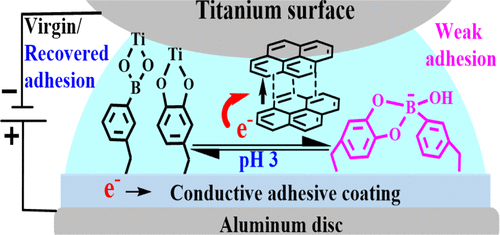当前位置:
X-MOL 学术
›
Biomacromolecules
›
论文详情
Our official English website, www.x-mol.net, welcomes your feedback! (Note: you will need to create a separate account there.)
Effect of Conductivity on In Situ Deactivation of Catechol–Boronate Complexation-Based Reversible Smart Adhesive
Biomacromolecules ( IF 6.2 ) Pub Date : 2021-08-19 , DOI: 10.1021/acs.biomac.1c00802 Md Saleh Akram Bhuiyan 1 , Bo Liu 1, 2 , James Manuel 1 , Bin Zhao 2 , Bruce P Lee 1
Biomacromolecules ( IF 6.2 ) Pub Date : 2021-08-19 , DOI: 10.1021/acs.biomac.1c00802 Md Saleh Akram Bhuiyan 1 , Bo Liu 1, 2 , James Manuel 1 , Bin Zhao 2 , Bruce P Lee 1
Affiliation

|
To reduce the need for elevated electrical potential to deactivate catechol-based smart adhesive and preserve its reversibility, conductive 1-pyrenemethyl methacrylate (PyMA) was incorporated into a catechol and phenylboronic acid-containing adhesive coating immobilized on aluminum (Al) discs. Electrochemical impedance spectroscopy (EIS) indicated that incorporation of 26 mol % of PyMA reduced ionic resistance (Rs) and charge-transfer resistance (Rc) of the coating from over 22 Ω/mm2 to 5.9 and 1.2 Ω/mm2, respectively. A custom-built Johnson–Kendall–Roberts (JKR) contact mechanics test setup was used to evaluate the adhesive property of the coating with in situ applied electricity using a titanium (Ti) sphere both as a test substrate as well as the cathode for application of electricity and the Al disc as the anode. The adhesive coating demonstrated over 95% reduction in the adhesive property when electricity (1–2 V) was applied while the adhesive was in direct contact with the Ti surface. The addition of PyMA enables the deactivation of the adhesive using a voltage as low as 1 V. Both cyclic voltammetry (CV) and attenuated total reflection-Fourier transform infrared (ATR-FTIR) spectra confirmed the formation of catechol–boronate complexation through electrochemical stimulation. Breaking the complex with an acidic buffer (pH 3) recovered the catechol for strong wet adhesion and the coating could be repeatedly deactivated and reactivated using low electrical potential for up to five cycles. Incorporation of both conductive PyMA and boronic acid as the temporary protecting group was required to achieve rapidly switchable adhesive that could be deactivated with low applied voltage.
中文翻译:

电导率对儿茶酚-硼酸酯络合型可逆智能粘合剂原位失活的影响
为了减少使基于儿茶酚的智能粘合剂失活并保持其可逆性所需的升高电位,将导电的 1-芘甲基丙烯酸甲酯 (PyMA) 加入固定在铝 (Al) 盘上的含儿茶酚和苯基硼酸的粘合剂涂层中。电化学阻抗谱 (EIS) 表明,加入 26 mol% 的 PyMA 将涂层的离子电阻 ( R s ) 和电荷转移电阻 ( R c ) 从超过 22 Ω/mm 2 降低到 5.9 和 1.2 Ω/mm 2, 分别。使用定制的 Johnson-Kendall-Roberts (JKR) 接触力学测试装置来评估涂层的粘合性能,并使用钛 (Ti) 球作为测试基材和阴极进行原位施加电力电和铝盘作为阳极。当粘合剂与 Ti 表面直接接触时,当施加电(1-2 V)时,粘合剂涂层的粘合性能降低了 95% 以上。添加 PyMA 可以使用低至 1 V 的电压使粘合剂失活。 循环伏安法 (CV) 和衰减全反射傅立叶变换红外 (ATR-FTIR) 光谱均证实通过电化学刺激形成儿茶酚 - 硼酸盐络合. 用酸性缓冲液 (pH 3) 破坏复合物可以恢复儿茶酚的强湿附着力,并且涂层可以使用低电位反复失活和重新激活,最多五个循环。需要结合导电 PyMA 和硼酸作为临时保护基团,以实现可快速切换的粘合剂,该粘合剂可以在低施加电压下失活。
更新日期:2021-09-13
中文翻译:

电导率对儿茶酚-硼酸酯络合型可逆智能粘合剂原位失活的影响
为了减少使基于儿茶酚的智能粘合剂失活并保持其可逆性所需的升高电位,将导电的 1-芘甲基丙烯酸甲酯 (PyMA) 加入固定在铝 (Al) 盘上的含儿茶酚和苯基硼酸的粘合剂涂层中。电化学阻抗谱 (EIS) 表明,加入 26 mol% 的 PyMA 将涂层的离子电阻 ( R s ) 和电荷转移电阻 ( R c ) 从超过 22 Ω/mm 2 降低到 5.9 和 1.2 Ω/mm 2, 分别。使用定制的 Johnson-Kendall-Roberts (JKR) 接触力学测试装置来评估涂层的粘合性能,并使用钛 (Ti) 球作为测试基材和阴极进行原位施加电力电和铝盘作为阳极。当粘合剂与 Ti 表面直接接触时,当施加电(1-2 V)时,粘合剂涂层的粘合性能降低了 95% 以上。添加 PyMA 可以使用低至 1 V 的电压使粘合剂失活。 循环伏安法 (CV) 和衰减全反射傅立叶变换红外 (ATR-FTIR) 光谱均证实通过电化学刺激形成儿茶酚 - 硼酸盐络合. 用酸性缓冲液 (pH 3) 破坏复合物可以恢复儿茶酚的强湿附着力,并且涂层可以使用低电位反复失活和重新激活,最多五个循环。需要结合导电 PyMA 和硼酸作为临时保护基团,以实现可快速切换的粘合剂,该粘合剂可以在低施加电压下失活。



























 京公网安备 11010802027423号
京公网安备 11010802027423号